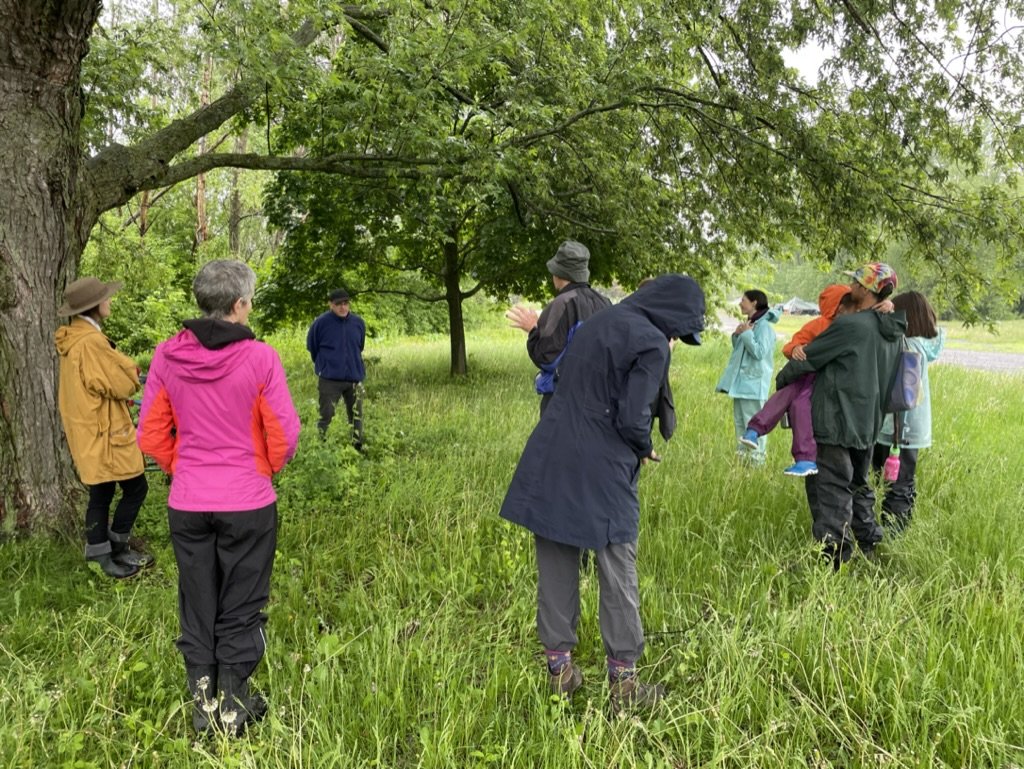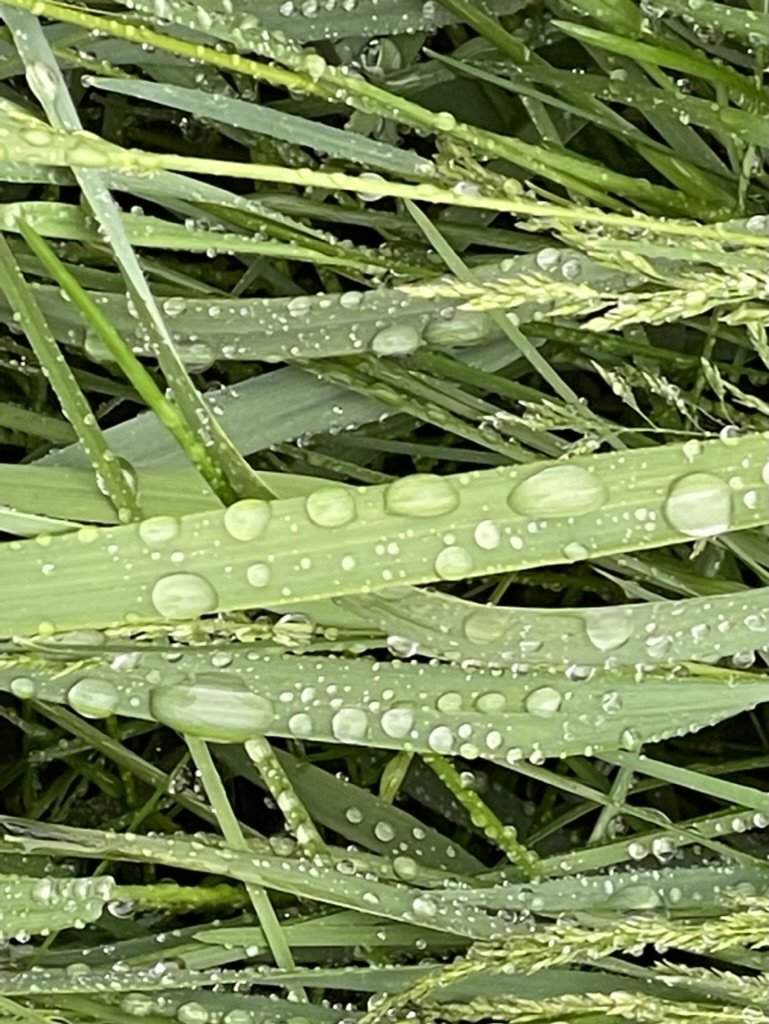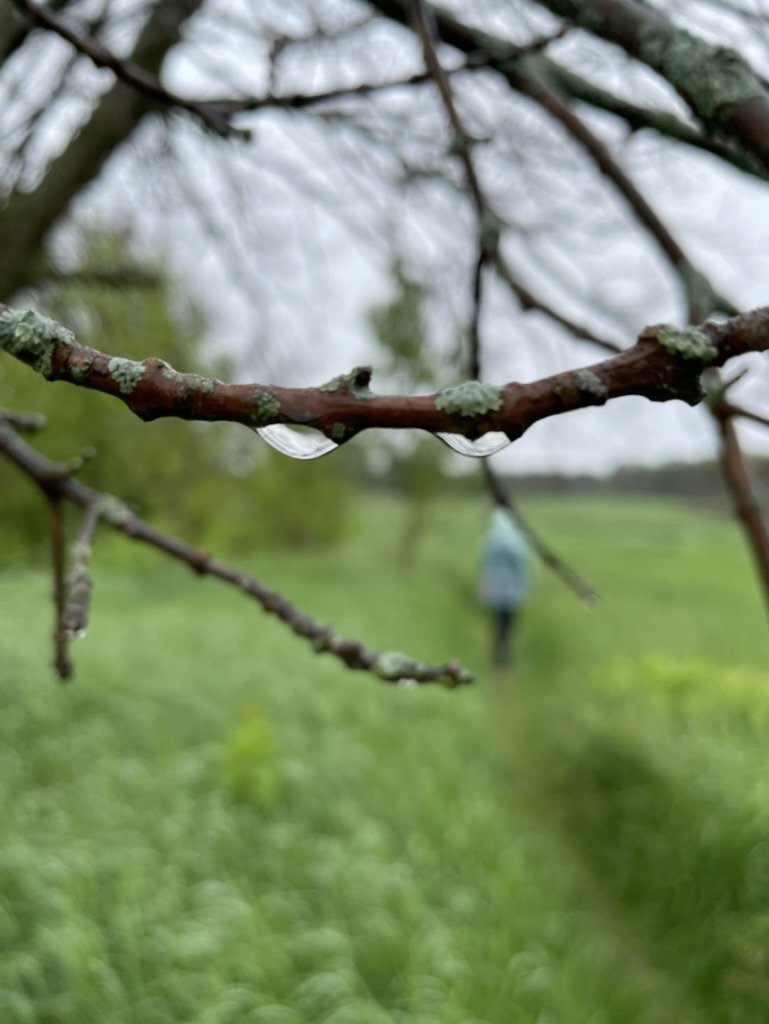Listening to the Dawn Chorus: A Soundwalk
27 May, 2022. It was overcast, verging on rain. A small group gathered at the entrance to Belle Park for Listening to the Dawn Chorus: A Soundwalk. Under the guidance of composer, sound artist, musicologist and Queen’s professor Matt Rogalsky, we were about to encounter place as a sonic composition — where each moment holds layers of sonic presence, unique to this place and moment, and distinct to each of us. Neighbours, friends, lovers of the park, geographers, lawyers and researchers arrived to participate.
We began by introducing ourselves.
F, who was on his way to Quattrocchi’s, the nearby family grocery store, and decided to join in the walk, said that when he first moved to this neighbourhood it took him three weeks to acclimatize to how much “nature” was integrated with “city.” A said they had a love of Belle Park and often walked around with their eyes shut. D, amazed at how nature can reclaim itself after serving other purposes, was curious about experiencing the space through the lens of its sounds. M’s dad woke her up and, well, here she was. Z and M #2. were too shy to speak, signalling from the get-go one of the lessons we would learn: that silence too traffics in the audible. T was excited to hear voices of birds. M-L, familiar with Matt’s work, wanted to hear Matt “do his thing,” while L sought to listen in the spirit of the book Hungry Listening (2020) by sound theorist Dylan Robinson (Stó: lō) — that is, they wanted to refuse “hungry listening” in favour of “listening otherwise.”
I live in Montreal and had only been to the park a couple of times, but I have been thinking for some time about using research-creation methodologies to rethink “challenging-to-inhabit spaces.” I wondered how sound might tell me more about how land can be haunted by the legacy of colonial pasts, and also by entities, events, systems and ecosystems human and other-than-human. Interested in spaces as “liquid ground” — land that isn’t fixed, but changeable, I brought with me the thought that a soundwalk might welcome the spectral, of perceiving the trace of ‘sounds past,’ echoes both present and absent. What about once-was am I no longer hearing in this place, and why, and how might I be responsive to this in future?
Speaking softly, Matt opened with, “I want to try an ‘extreme slow walk.’”
*****
When there is so much sensual data to take in, what does it mean to do an “extreme slow walk” through a semi-abandoned park? I studied some time ago with sound artist and curator Christof Migone, so I was familiar with considering the “eventlessness” of a space, ready to listen within and beyond the birdsong, wind, rain sounds and the plethora of cars cruising by on Montreal street.
But Matt’s soundwalk proposed something deeper: a meditative practice that would put into practice (perhaps) one way to collectively question colonial practices of extracting and naming—in this case, of sounds, as underlined in Robinson’s book. Matt carries with him lessons from time spent with Pauline Oliveros and her “Deep Listening” strategies; he is influenced by notions of “acoustic ecology” as taught and theorized by Barry Truax and others.
In particular, Matt cited the work of Hildegard Westercamp, an acoustic ecologist who founded the Vancouver Soundwalk Collective, in which composers, sound designers and soundwalk leaders change listening behaviours as a way towards protecting environments they care about. Key to the practice of extreme slow walking and listening is the idea of reciprocity. In each experience of a place a score is continually unfolding, an ongoing improvisation and conversation of both turning down or amplifying sounds encountered and made by us. As we move in the world, we make noise, and we position ourselves, so that by listening we actively compose sounds into a soundscape that is unique to us.
We began by arranging ourselves into a circle.
Matt read from Pauline Oliveros’ sonic meditations (1971) no 5, a group meditation exercise:
Heightened states of awareness or expanded consciousness, changes in physiology and ·psychology from known and unknown tensions to relaxations which gradually become permanent… Music is a welcome by-product of this activity.
To start the soundwalk, we first needed to tune our bodies like instruments for the composition ahead. Matt took us through a “tuning meditation,” asking us to begin by feeling the weight or lightness, the heavy or faint resonance of our own sounds coming out of our bodies.
The direction was:
Sing, hum or coo in response to a sound you hear in the park. Then listen to your companions’ sounds and mimic one of the sounds. Let the expressions building up in rounds, breaking to breathe. Formulate an ever-expanding set of vibrations into the atmosphere.
*****
Matt asked, What are we really walking on here and what has it become? How does one give back? Are we more oriented culturally to the visual over the auditory?
The group discussed how people are so good at habituating to sounds around them, even deafening cacophonies, that quiet spaces can seem empty of sound. I think of John Cage’s infamous statement, that “there is not such thing as silence. Something is always happening that makes sound,” or Susan Sontag’s suggestion that to perceive silence is dependent upon, implies the presence of, and is dependent on its very opposite: sound. But which sounds? Our sensory knowledge is often biased. Some of us can tune things out, integrating or filtering a huge range of sounds. Neurodiverse folks might feel such an array to be overwhelming. There is no one way to listen. In fact Matt suggested that our ears produce sound as a way of becoming part of the sonic environment — so we are part of what we hear.
As the rain lifted we set out on a path bordered by a fence on one side, a grove of trees on the other side, heading towards an open field that was flattened in places by storm winds from the night before. Or maybe by large sleeping beasts: who slept here, I wondered?
The cue, a poetic instruction originally given by Pauline Oliveros, was: walk as if the bottom of your feet are ears.
We walked extremely slowly, forming a line at first that eventually dispersed. As instructed, we listened up-close and as-faraway-as-you-can. Some of us closed our eyes, guided by textures underfoot, the sound of our own breath, sweat, our arm brushing up against a fence or a tree branch.
Gathering again, we debriefed:
A: There is so much self-monitoring when we slow down. I found I was holding my breath, trying to be invisible to the birds, until I heard myself walking, and thought, Oh: that’s me…
F: Slowing down helped me hear the birds; I felt how I privilege my ears over my eyes I didn’t feel guilty about not-knowing which bird I was hearing.
A: I was trying to turn off my eyes. What are the leaves like? What are the grasses “saying”?
M-L: The wind was activating things, shifting the sense of scale.
F: My eardrums were once blown and I developed amplified tinnitus. At the time I became a recluse. There is a beauty in each person’s voice when you take time to be in more silence than sound and I felt this deeply on this walk.
D: As we walked I was translating the surfaces, the layers of grass, soil, as if I was an insect on the ground. There were drumbeats of birds.
F: And the base note of a train is grounding. Also opening onto new dimensions.
As for me, I tried to listen vertically down through the soles of my feet into the ground to feel, to hear, what haunts Belle Park.
Photos by Dorit Naaman.
Alisha Piercy is a PhD student in Cultural Studies at Queen’s and a summer 2022 Research Assistant for the Belle Park Project. Alisha’s research-creation interests include speculative worlding compositions/fictions, other-than-human hauntologies and Critical Animal Studies. Her interdisciplinary art practice explores film and performative drawing installation, and she is the author of poetry, novels, and texts in collaboration with artists. Bunny and Shark, her first novel, was published with Book*hug (Toronto). Her collaborative short film Howe Are You Island? shows in September 2022 at the Athens Digital Arts Festival and the Grande rencontre des arts médiatiques in Gaspésie, Québec. Her website is https://alishapiercy.com/.



